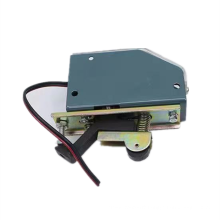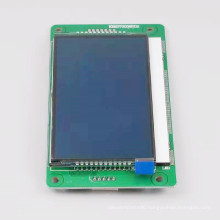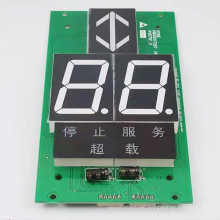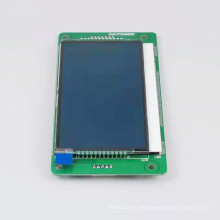Elevator electrical maintenance skills - Solutions - Huaqiang Electronic Network
2021-04-19
Safety loop function:
In order to ensure that the elevator can operate safely, many safety components are installed on the elevator. Only when each safety component is under normal conditions can the elevator run, otherwise the elevator will stop running immediately.
The so-called safety circuit is to install a safety switch in each safety part of the elevator, connect all the safety switches in series, and control a safety relay. Only when all safety switches are switched on, the safety relays can be energized and the elevator can be operated electrically.
l Common safety circuit switches are:
Computer room: control panel emergency stop switch, phase sequence relay, thermal relay, speed limiter switch shaft: upper limit switch, lower limit switch (some elevators put these two switches in the safety loop, and some use these two Switch directly controls the power supply)
Pit: Broken rope protection switch, pit repair box emergency stop switch, buffer switch car: control box emergency stop switch car top: safety window switch, safety clamp switch, car top inspection box emergency stop switch fault status:
When the elevator is in a stopped state, all signals cannot be registered, and the express train cannot operate. First, it is suspected that the safety loop is faulty. You should go to the equipment room control panel to observe the status of the safety relay. If the safety relay is in the released state, it should be judged as a safety loop failure.
Possible causes of failure:
1. The phase sequence of the input power supply is wrong or there is a phase loss that causes the phase sequence relay to operate.
2. The elevator is overloaded or blocked for a long time, causing the thermal relay to operate.
3. It is possible that the speed limiter overspeed causes the speed limiter to switch.
4. The elevator tops or sinks to the limit switch action.
5. The pit break rope switch action. It may be that the speed limiter jumps out or is too long.
6. Safety gear action. The cause should be identified. It may be that the speed limiter is overspeeding, the speed limiter loses oil and malfunctions, the pit rope wheel loses oil, the ground rope wheel has foreign objects (such as rats), and the safety block gap is too small.
7. The safety window is lifted up by the person, causing the safety window to switch.
8. There may be an emergency stop switch pressed.
9. If the switches are normal, check that the contacts are in good contact and that the wiring is loose.
In addition, at present, many elevators have normal safety circuits and safety relays. However, usually take a normally open contact on the safety relay and send it to the microcomputer (or PC) for testing. If the safety relay itself is in poor contact, A state that causes a safety loop failure. Door lock loop function:
In order to ensure that the elevator must be operated after all doors are closed, a door electrical interlock switch is installed on each hall door and car door. Only when all the door electrical interlock switches are fully connected, the door lock relay of the control panel can be closed and the elevator can operate. Fault status:
When all the doors are closed, observe the state of the door lock relay to the control panel. If the door lock relay is in the released state, it should be judged that the door lock circuit is open.
Maintenance method:
Since most of the elevators currently cannot operate when the door lock is disconnected, the door lock failure is easy to judge, but it is difficult to find out which door is faulty.
My repair advice:
1. First of all, we should focus on whether the door lock of the elevator stop layer is faulty.
2. Ask if there is a triangular key to open the door and re-open the door with a triangular key outside the hall.
3. Make sure that in the inspection state, the control panel is short-circuited between the hall door lock and the hall door lock, and the separation is the hall door part or the car door part failure.
4. If the hall door is partially faulty, make sure that the door lock circuit is shorted in the maintenance state, run the elevator at the inspection speed, and check the interlocking contact of each hall door layer by layer (don't forget the passive door).
Note: After repairing the door lock loop fault, you must first remove the door lock short wire before returning the elevator to the express state.
In addition, at present, many elevators have normal door lock circuits, and the door lock relays are also sucked. However, usually a normally open contact is taken on the door lock relay and sent to the microcomputer (or PC) for detection if the door lock relay itself contacts. Bad, it will also cause the door lock loop to fail. Safety touch panel (door photoelectric, door light curtain)
effect:
In order to prevent the elevator door from pinching the passenger during the closing process, a safety touch panel (or photoelectric or light curtain) is generally mounted on the elevator car door.
Safety touch panel: It is a mechanical anti-pinch device. When the elevator touches the door, when the person touches the safety touch panel, the safety touch panel is inwardly retracted, driving a lower micro switch, the safety touch panel switch action, and controlling The door turns in the direction of opening the door.
Photoelectric: Some elevators are equipped with door optoelectronics (at least two points are required), one side is the transmitting end and the other side is the receiving end. When the elevator door is closed, if an object blocks the light, the receiving end can not receive the light source of the transmitting end, and immediately drives the photoelectric relay to operate, and the photoelectric relay controls the door to open in the opposite direction.
Light curtain: The principle is the same as photoelectric, but there are many launch points and receiving points. Fault status:
1. The elevator door cannot be closed: the elevator cannot be closed when it is in the automatic position, or it is reversed when it is not closed. It can be closed during maintenance.
the reason:
If the safety touch panel switch is broken, or it is stuck, or the switch is improperly adjusted, the safety touch panel will cause the switch to operate when it is slightly operated.
The door optoelectronic (or light curtain) position is biased or blocked. The OR gate has no (light curtain) power supply, or the photoelectric (light curtain) is broken. 2. The safety touch panel does not work. Cause:
The safety touch panel switch is broken or the line is broken.
service:
Repair after finding out the cause. Closing force limit switch function:
Some elevator doors are equipped with door force limit switches. When the door is closed due to a certain resistance during the closing process, the switch acts and the door rotates in the direction of opening the door.
Some inverter door machines do not have this switch, but they have similar functions. If there is a certain resistance when closing the door, if the calculation of the door machine current exceeds a certain value through the inverter, it cannot be closed, then it will open in the opposite direction. Fault status:
When the door closing limit switch has a malfunction, the door will never close. Switch door button function:
When the automatic position is pressed, if the door opening button is pressed and held, the elevator door is opened for a long time, which can facilitate the passengers to enter and exit the car normally for a long time.
Press the close button to close the door immediately.
Used to control the opening and closing of the elevator when the position is overhauled. Failure phenomenon:
Sometimes when the switch door button is pressed, it will not click out. If the door open button is stuck, it may cause the elevator to reach the back door and keep the door open. When the door close button is jammed, it will cause the back door not to be opened. service:
Identify the cause and ensure that the button action is flexible and reliable. Call outside the hall button:
The call outside the hall button is used to register the call of the passenger outside the hall. At the same time, it has the function of opening the door in the same direction. If the elevator is running up, if the call is held down, the elevator door will open for a long time. (Some elevators are designed to be closed after a certain period of time). Failure phenomenon:
Sometimes the elevator will stop at this level and the door will not close when the call button is stuck. Or after a period of forced forced closing, then drive to the floor for a period of time each time. service:
Identify the cause and ensure that the button action is flexible and reliable.
Door machine system
1. The working principle diagram of the general DC Door System of the DC door system is as follows:  Working principle analysis:
Working principle analysis:
Opening the door: When JKM pulls in, the current passes through the motor rotor DM on the one hand, and the door opening resistance RKM on the other hand, from M2 → M3, causes the door machine to rotate in the direction of opening the door, because the RKM resistance value is larger at this time, and the shunt through RKM Smaller. Therefore, the door opening speed is faster. When the elevator door is closed to 3/4 stroke, the switch deceleration limit 1KM is turned on, and most of the resistance of the RKM is shorted, so that the shunt through the RKM is increased, thereby reducing the motor speed and realizing the function of deceleration of the door opening. . When the door is opened, the door opening interruption limit is cut off, the door opening relay is released, and the elevator stops opening the door.
Closing: When the JGM is pulled, the current passes through the DM on the one hand, and the door closer in the closing direction is from M3 → M2 through the closing resistance RGM on the other hand. Because the RGM resistance value is large at this time, the shunt through the RGM is small, so the closing speed is faster. When the elevator is closed to half of the stroke, the first-level deceleration limit 1GM is turned on, and a part of the resistance of the RGM is short-circuited, so that the shunt from the RGM is increased, and the door machine realizes one-stage deceleration. When the elevator door continues to close to 3/4 stroke, the secondary deceleration limit 2GM is turned on, and most of the resistance of the RGM is shorted, so that the shunt from the RGM is further increased, and the elevator door machine speed is further reduced, achieving the second level of closing. slow down. When the door is closed, the door closing limit is cut off, the door closing relay is released, and the elevator stops closing.
The total speed of the switch door can be controlled by adjusting the total voltage dividing resistor RMD in the switch gate circuit.
Because when the JY pulls in, the door motor excitation winding DMO always has electricity, so when the JKM or JGM is released, the motor can immediately enter the energy consumption brake, and the door machine stops immediately. Moreover, when the elevator door is closed, a braking force can be provided to ensure that the elevator door cannot be easily opened in the car. Common faults in DC door systems:
Phenomenon 1:
The elevator opens without a deceleration. There is a crash. the reason:
When the door is opened, the door opening deceleration limit cannot be reached.
The door opening deceleration limit is broken and cannot be turned on.
The door opening deceleration resistor has been blown or the middle hoop is in poor contact with the resistance wire. Phenomenon 2:
The elevator is closed without deceleration, and the door closing speed is fast.
When the door is closed, the door deceleration limit cannot be reached.
The door closing deceleration limit is broken and cannot be turned on.
The closing speed reduction resistor has been blown or the middle hoop is in poor contact with the resistance wire. Phenomenon 3: The speed is too slow when opening or closing the door.
Cause: The door opening or closing speed reduction limit has been broken and is in the normally on state. Phenomenon 4: The door can't be closed only (JKM and JGM are working normally)
Reason: It may be that the terminal limit of the door is broken and it is always off. Phenomenon 5: The door can't be opened only (JKM and JGM operate normally)
Reason: It may be that the limit of the door opening terminal is broken and it is always in the disconnected state. Phenomenon 6: The door cannot be opened or closed (JKM and JGM operate normally)
Cause: It may be that the total resistance of the switch door has been blown. 2. VVVF inverter door machine system mostly uses VVVF frequency conversion door machine system. In the general frequency conversion door machine system, the control screen provides a power supply to the door machine system, a door opening signal and a door closing signal.
The frequency conversion door system also has a deceleration switch and a terminal switch, and most of them adopt a bistable magnetic switch. The door machine system has a self-learning function. When the switch to the door machine is activated, it returns to the control panel with a terminal signal for controlling the switch door relay.
Generally, the frequency conversion door machine can set the door speed, torque and deceleration point position. For details, please refer to the door machine system manual provided by the manufacturer or the elevator debugging data for adjustment.
Some inverter door machines lose their position signal after the power is turned off. The door machine will no longer be controlled by the control panel switch door signal. It must be self-learned after power off to work normally.
In addition to being controlled by the control panel switch door signal, some inverter door machine systems have their own limit calculation function. When the force limit exceeds the set value during the door closing process, it is turned to the opposite direction. This force limit calculation fails when the door closing switch is actuated. For this kind of door system, the position of the door closing terminal must exceed the car door lock. Otherwise, the elevator can be operated after the door lock is connected. If the force limit calculation is still valid, it may cause the elevator to open the door during operation. Should be noted. (I personally think that this design is unreasonable, the door machine system must always be controlled by the control panel, but not self-contained)
Limitation of the upper and lower ends of the hoistway:
The upper terminal limit is generally operated when the elevator runs to the highest level and is 5-8 cm higher than the leveling layer. After the action, both the elevator express and the slow train can no longer run upwards.
Conversely, the lower terminal limit is generally operated when the elevator runs to the lowest level and is lower than the level 5-8CM. After the action, both the elevator express and the slow train cannot run down. Symptom 1: Both the elevator express and the slow train cannot run up, but can run down.
Cause: The upper terminal may be in a bad position and in the disconnected state. Symptom 2: Both the elevator express and the slow train cannot run down, but can run upwards.
Cause: It may be that the lower terminal is in a bad position and is in the disconnected state. Elevators with a speed reduction of 1 m/s or less above and below the hoistway are generally equipped with an upward forced deceleration limit and a downward forced deceleration limit. The installation position should be equal to (or slightly less than) the deceleration distance of the elevator. Elevators with speeds above 1.5 m/s are generally equipped with two upward forced deceleration limits and two downward forced deceleration limits. Because the fast elevator is generally divided into two types of single-layer running speed and multi-layer running speed, the deceleration distance is different under different speeds, so it is necessary to divide the multi-layer running deceleration limit and the single-layer running deceleration limit. Function 1: Force the elevator into deceleration when the elevator runs to the end station.
Role 2: At present, many elevators use the forced deceleration limit as the forcing correction point of the elevator floor position. Symptom 1: Elevator Express cannot run up, but slow train can.
Reason: It may be that the upward forced deceleration limit is broken and is in the off state. Symptom 2: The elevator express cannot run down, but the slow train can.
Reason: It may be that the upward forced deceleration limit is broken and is in the off state. Symptom 3: The elevator is in a fault state and the program is protected. It is possible to display the fault switch as a speed change switch fault.
Reason: It may be that the deceleration limit is forced up or down. Because forced deceleration limit is very important in elevator safety, many elevator programs are designed to have a detection function for this limit. If the limit is detected, the program protection is started. The elevator is in a "dead" state. Selector function:
Calculate the actual position of the elevator currently in operation. Type of selector:
1. Mechanical Conveyor The earlier elevators used mechanical type selectors, some of which used synchronous steel belts, some used chasing machines, and the operation of the elevators, the simulation reflected the actual position of the elevator. 2. There are elevators in the hoistway floor sensor. The calculation of the elevator position is based on the fact that one magnetic sensor is installed in each layer of the hoistway, and a magnetic isolation plate is installed on the side of the car. When the magnetic isolation plate is inserted into the sensor, the sensor acts. After the control panel receives the signal from the sensor, it immediately calculates the actual position of the elevator. At the same time, the control display shows the floor number of the elevator. Failure phenomenon:
The elevator must determine the direction of operation. It is necessary to know the current location of the elevator. Therefore, the determination of the elevator position is very important. If some of the circuits fail, the elevator may not automatically determine the running direction, and the signal registration may not occur. .
Similarly, when this part of the circuit fails, it will generally cause the incorrect display of the numbers on the floor.
(Please look at the floor control part and automatic orientation part of the relay elevator in detail.) 3. Car speed change sensor At present, some elevators save the floor sensor, and the speed sensor installed on the car calculates the floor. (such as the house factory).
The elevator is equipped with an upper speed change sensor and a lower speed change sensor on the side of the car. The upper speed change point and the downward speed change point of each floor stop in the hoistway are respectively equipped with a short magnetic isolation. board.
When the elevator goes up, when the speed change point is reached, the magnetic isolation board is inserted into the sensor, the sensor acts, and the control panel receives a signal, so that the original floor number is automatically increased by one.
When the elevator goes down, when the speed change point is reached, the magnetic isolation board is inserted into the sensor, the sensor acts, and the control panel receives a signal to automatically reduce the original floor number by one.
When the elevator reaches the bottom level, the elevator floor number can be forcibly converted to the lowest layer number when the lower forced deceleration limit action is performed.
When the elevator reaches the highest level, when the upper forced deceleration limit action is performed, the elevator floor number can be forcibly converted to the highest level. Failure phenomenon:
Elevators of this type often cause chaos in the elevator during operation.
For example, when the upper speed change sensor is broken (cannot be operated), the number will not be reversed when the elevator is running upwards, nor can it stop at the designated floor, but it will run up to the highest level all the time, and the floor number will be turned to the highest level. Slow down the elevator at the highest level. 4. Digital Selector The so-called digital layer selector is actually a device that uses the number of pulses obtained by a rotary encoder to calculate the floor. This is more common in most inverter elevators.
principle:
A rotary encoder mounted on the end of the motor (or the governor shaft) rotates synchronously with the electric power. The rotary encoder can emit a certain number of pulses (typically 600 or 1024) per revolution of the motor.
After the installation of the elevator is completed, it is generally necessary to write the height of the floor. This step is to store the pulse number of each floor and the number of deceleration distance pulses into the computer in advance. In the future operation, the operation of the rotary encoder The number of pulses is then compared with the stored data to calculate the location of the elevator.
In general, the rotary encoder can also obtain a speed signal that is fed back to the frequency converter to adjust the output data of the frequency converter.
Failure phenomenon:
1. When the rotary encoder is bad (no output), the inverter can not work normally, it becomes very slow, and the inverter is protected for a while, and the message “PG disconnection” is displayed.
2. When the partial encoder of the rotary encoder is broken, the pulse will be lost during operation, and the elevator will vibrate during operation and the comfort will be poor. service:
The wiring of the rotary encoder should be secure, and the wiring should leave the power line to prevent interference.
Sometimes the housing can be removed for cleaning due to contamination of the rotary encoder, clogging of the grating, and the like.
Note: The rotary encoder is a precision electromechanical device that should be handled with care. Car upper and lower level sensor function:
1, used to carry out the crawling level of the car
3. Used to signal the signal failure of the feedback gate area:
When the leveling sensor does not operate (or the position of the magnetic isolation plate inserted into the sensor is too large), the elevator may not level off after decelerating, but continue to travel slowly.
Some elevator programs can detect the action of the leveling sensor. For example, when the elevator runs fast, it is necessary to detect the leveling signal when it reaches a certain time. Otherwise, the sensor is considered to be in error, and the program immediately feeds back the elevator fault signal. The function of the weighing device: it is used to measure the load of the elevator and emit signals such as light load, full load and overload. Some can compensate for the elevator operation. Cooperate with anti-tampering functions. Fault phenomenon: It mainly prevents the position of the weighing device from shifting, causing malfunction. At this time, it is necessary to re-test the position. Failure to do so may cause the elevator to crash.
We carry OEM parts for all major elevator and escalator brands:
Elevator doors, elevator automatic doors, elevator VVVF door, Mitsubishi elevator doors, Selcom elevator doors, WITTUR elevator doors, elevator door drive, Elevator door controller, elevator complete doors, elevator complete door system, elevator door modernization, elevator door operator, Selcom Hydra Plus elevator door operator, elevator door motor, elevator door lock, elevator door parts, elevator landing door, elevator landing door operator, elevator landing door device, elevator landing door hanger, elevator landing door Mechanism, elevator landing door header, Fermator elevator doors
Elevator Door System, Lift Door System
Elevator Automatic Door, Lift Automatic Door,
Elevator Cabin Door, Elevator Car Door, Elevator Cab Door
Lift Cabin Door, Lift Car Door, Lift Cab Door
Elevator Landing Door, Lift Landing Door
Cabin Door Operator, Car Door Operator, Cab Door Operator
Landing Door Device, Landing Door Mechanism, Landing Door Hanger, Landing Door Header
OTIS Elevator Door System, Thyssen Elevator Door System, KONE Elevator Door System, GiantKONE Elevator Door System, ThyssenKrupp Elevator Door System, Schindler Elevator Door System, XJ Schindler Elevator Door System, Xizi OTIS Elevator Door System, Mitsubishi Elevator Door System, Shanghai Mitsubishi Elevator Door System, Fujitec Elevator Door System, Hitachi Elevator Door System, Toshiba Elevator Door System, Hyundai Elevator Door System, LG Elevator Door System, Sigma Elevator Door System, Express Elevator Door System, GUANGRI Elevator Door System, FUJI Elevator Door System, BLT Elevator Door System, CANNY Elevator Door System, SJEC Elevator Door System, KOYO Elevator Door System, IFE Elevator Door System
Elevator Automatic Doors, Elevator VVVF Doors, Mitsubishi Elevator Doors, Selcom Elevator Doors, Fermator Elevator Doors, Elevator Doors
Sunny Elevator Co., Ltd. http://www.zjfullelevatorreplacement.com









